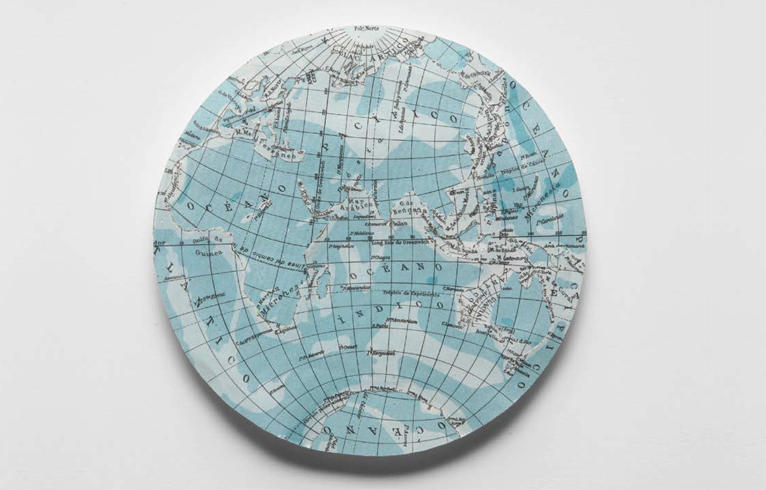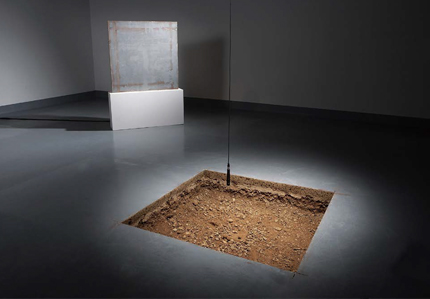18TH BIENNALE OF SYDNEY: ALL OUR RELATIONS
| November 20, 2012 | Post In LEAP 17

It was on Saturday, August 25 that I set out to see the 18th Biennale of Sydney, “All Our Relations.” Coincidentally the day was to be shared with the passing of the first man to walk on the moon, Neil Armstrong. Though obviously unrelated, the fact remained present in my mind as I traversed the Biennale’s multiple venues— the Art Gallery of New South Wales, the Museum of Contemporary Art Australia, Cockatoo Island, Pier 2/3, and Carriageworks. By chance, at my first stop— the Art Gallery of New South Wales— I was greeted by Jorge Macchi’s image of Earth. Titled Blue Planet (2003), the work was constructed from sections of maps and cut and pasted in a way that rendered the entirety of the Earth’s surface blue with ocean. Looking at Macchi’s work I thought of Armstrong’s “one small step for man, one giant leap for mankind,” the crowning moment of the Space Race that had made such imaginings of our planet possible. I also thought about the environmental movement for which such images had become the public face— Macchi’s work, in its illustration of the potential impact of global warming, had so clearly tapped this.
Viewed from space, the wholeness and fragility of Earth becomes clearly articulated, providing a suitable image of what lies at stake or needs to be preserved globally by humans. As the first work in “In Finite Blue Planet”— one of the Biennale’s many sub-themes— Macchi’s Blue Planet set the tone for the exhibition to follow, which proposed to evoke “a new consciousness of the finite— rather than the infinite— nature of our blue planet and its resources.” Here the viewer was ushered through a procession of works that moved from a macro to micro view of Earth: from Macchi’s images of the globe, to Subhankar Banerjee’s meditative videos Caribou Tracks and Coal Seams II (2006) that use bird’s-eye views to track landscapes and animal migration, onto standout works such as City of Ghost 2007 by Nipan Oranniwesna, which meticulously traced maps of urban metropolises in talcum powder and caused viewers to hold their breath in fear of unsettling the dust. At its conclusion was Postcommodity’s Do You Remember When? (2009-12), a work which saw a section of the gallery’s concrete floor removed to expose the earth beneath. Above hung a microphone emitting a sound piece produced in collaboration with local Aboriginal people.
The Biennale’s presentation at the Art Gallery of New South Wales clearly exemplified the considered and steady hand of the two artistic directors— Catherine de Zegher and Gerald McMaster— in shaping a oneness, or wholeness of vision, across their selection. This was a sense that continued across the other venues, albeit under more open-ended and abstract propositions: the Museum of Contemporary Art Australia touting the theme “Possible Compositions,” Cockatoo Island “Stories, Senses and Spheres,” and Pier 2/3 “As Above, As Below.” While the Art Gallery of New South Wales followed a linear progression and concentrated on work that was more documentary-like in nature, the other venues were notable for the similarity of form, material and color that they brought together. For example, in one room of the Museum of Contemporary Art Australia, the Biennale reached its most high-key moment, placing in close proximity color field abstractions by the late David Aspden, curled sheets of paint peeled from canvases and left free standing for sculptural effect by Mit Jai Inn, and a video that saw artists Gabriella Mangano and Silvana Mangano enact simple choreography beneath a multi-colored piece of plastic in order to create form. By the time I had left the Museum of Contemporary Art Australia and reached the other venues, such formally tight arrangements were beginning to make the Biennale look tired, suffering from a sameness that, unnecessary and incongruous across such a scale, struggled to communicate ideas in depth.
This repetitiveness was further exemplified by the inclusion of a mirror foil work by Anne Veronica Janssens on Cockatoo Island, alongside a similar presentation of work in the cavernous, industrial foyer of the Carriageworks multidisciplinary arts center— the newest addition to the Biennale’s venues. Unfortunately, the visual impact of Janssens’ materiality was diffused at Carriageworks if visitors had already traveled elsewhere. However, with the presentation of the major dance works Et Atendant (2010-12) and Cesna (2011-12) by choreographer Anne Teresa De Keersmaeker and her company Rosas yet to come, it awaits to be seen if the potential of Carriageworks as a Biennale venue will be fulfilled.

The appointment of two artistic directors was marketed as the defining point of the Sydney Biennale’s eighteenth iteration. In its realization, however, what became most interesting about the “two curators in conversation” was how the internal dynamics of this was indiscernible within the show. It appeared that the two curators’ voices had found consensus both in the inclusive “our” of the Biennale’s rhetoric and in the overt aestheticization of the hang. Similarly subsumed, and much to the detriment of the Biennale, were the efforts of the artists. Works struggled to assert their autonomous authority and seemed depoliticized by the Biennale as a whole. This was particularly problematic, as “All Our Relations” was notable for the inclusion of lesser-known artists from diverse and often underrepresented geographical spheres outside of Euro-America— despite its use of the possessive pronoun “our,” the theme failed to address the power dynamic of who held the agency and was speaking for whom. At its other extreme, the theme often became frustratingly literal, with works such as Lee Wingwei’s Mending Project (2009), which articulated the idea of relations through audience participation, but was inert and uninteresting in its presentation.
Despite this, there were still some enjoyable moments and works. Guido van der Werve’s Nummer Acht: Everything is going to be alright (2007) asserted the continued power of the sublime, through its mesmerizing footage of the artist’s steady paces forward in front of a monumental ice breaker cutting its way through arctic surroundings. The pairing of Park Young-Sook’s beautifully handcrafted White Porcelain Moon Jars (2006) with Yesookyung’s reworking of these objects in Translated Vase – the Moon (2006)— large spheres constructed out of Young-Sook’s discarded detritus of failed moon jars wrought together with gold— was striking in its simplicity and effectiveness in elaborating ideas between forms. Also proving popular with the crowds was Philip Beesley’s interactive Hylozoic Series: Sibyl (2012), which allowed visitors to get lost within a whimsical environment of plant-like forms that, as if alive, responded to human touch. Bahar Behbahani and Almagul Menlibayeva’s two-channel installation Ride the Caspian (2011) ironically provided relief from the rest of the Biennale, by providing a moment of much-needed tension through its play between ambiguous scenes set on the borders of the Caspian Sea.
Looking at the Biennale with Neil Armstrong in mind, I could not help but think about the complications of that historical moment that the moon landing marked, of the significance of Armstrong’s action in terms of mankind as a whole, and the national, political, and economic factors that had made it possible. Importantly, the moon still bears the American flag, and many of the tensions that marked the Cold War still persist. These are details much of the Biennale tried to omit in its “worldview.” I could also not help but consider what Armstrong’s view would have been when he turned around to look away from Earth, to the viewpoint we share from here, a viewpoint that opens out into the infiniteness of the universe, which we have little control over. Whether the universe started with a trickle, a bang, or a God, there is a natural violence and force implied in creation. Despite an appearance of passivity, the 18th Biennale of Sydney has applied such force in its shaping. Susan Gibb

